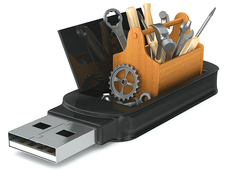Creating multiboot-capable USB sticks
Many Boots

A USB stick holding all the distributions you need can be a useful mobile toolbox. This month we explore three tools for creating multiboot-capable memory sticks.
Live boot has been part of the Linux scene for many years. The idea behind live boot is simple but very powerful: Carry the operating system with you wherever you go, and when you need it, plug it in and boot to it. Live systems let you test out an operating system before you install, which is why several common Linux distros offer pre-built live DVD images. Perhaps the most famous use for Live systems is troubleshooting. If a hard drive failure or a corrupt configuration file prevents the installed system from booting, you can boot to a live disc and start searching for the source of the trouble. Distros such as Knoppix and SystemRescueCd became famous as tools for system administrators to carry with them when called to rescue failed computers.
Old-school live systems traveled around on a CD or DVD – typically read-only media, which was a limitation on their suitability for everyday use. In the age of USB sticks, live systems have become more flexible. Support for persistence means you can customize the system in ways that were not possible with the older generation. USB sticks have also eliminated the strict size limitations that affect CDs and DVDs. USB sticks come in an assortment of sizes, and some are bigger than hard drives were in the not-so-distant past.
The large size and flexibility of USB sticks has led to another important innovation in live Linux. The first USB-based live systems were modeled on the previous CD/DVD model. You burned a system image to the stick, then started the system with the disc in place to boot the image. The best of the new live boot tools take the technology to another level. These tools basically load a boot manager onto the USB stick, then let you copy multiple system images onto the disc. You can therefore boot multiple operating systems from the same USB stick.
[...]
Buy this article as PDF
(incl. VAT)
Buy Linux Magazine
Subscribe to our Linux Newsletters
Find Linux and Open Source Jobs
Subscribe to our ADMIN Newsletters
Support Our Work
Linux Magazine content is made possible with support from readers like you. Please consider contributing when you’ve found an article to be beneficial.

News
-
Two New Distros Adopt Enlightenment
MX Moksha and AV Linux 25 join ranks with Bodhi Linux and embrace the Enlightenment desktop.
-
Solus Linux 4.8 Removes Python 2
Solus Linux 4.8 has been released with the latest Linux kernel, updated desktops, and a key removal.
-
Zorin OS 18 Hits over a Million Downloads
If you doubt Linux isn't gaining popularity, you only have to look at Zorin OS's download numbers.
-
TUXEDO Computers Scraps Snapdragon X1E-Based Laptop
Due to issues with a Snapdragon CPU, TUXEDO Computers has cancelled its plans to release a laptop based on this elite hardware.
-
Debian Unleashes Debian Libre Live
Debian Libre Live keeps your machine free of proprietary software.
-
Valve Announces Pending Release of Steam Machine
Shout it to the heavens: Steam Machine, powered by Linux, is set to arrive in 2026.
-
Happy Birthday, ADMIN Magazine!
ADMIN is celebrating its 15th anniversary with issue #90.
-
Another Linux Malware Discovered
Russian hackers use Hyper-V to hide malware within Linux virtual machines.
-
TUXEDO Computers Announces a New InfinityBook
TUXEDO Computers is at it again with a new InfinityBook that will meet your professional and gaming needs.
-
SUSE Dives into the Agentic AI Pool
SUSE becomes the first open source company to adopt agentic AI with SUSE Enterprise Linux 16.

